Statistical Characteristics of Strong Earthquake Sequence in Northeastern Tibetan Plateau
Abstract
:1. Introduction
2. Materials and Methods
2.1. Study Area and Data Selection
2.2. Seismic Event Supplement Technique Based on Statistical Seismology
2.3. ETAS Model
2.4. b Value
3. Results
Supplemental Data on Missing Earthquakes
4. Discussion
4.1. ETAS Parameter
4.2. Implication on Earthquake Forecasting
4.3. Constraints and Challenges
5. Conclusions
Author Contributions
Funding
Institutional Review Board Statement
Data Availability Statement
Acknowledgments
Conflicts of Interest
References
- Chapron, E.; Ariztegui, D.; Mulsow, S.; Villarosa, G.; Pino, M.; Outes, V.; Juvignié, E.; Crivelli, E. Impact of the 1960 major subduction earthquake in northern patagonia (Chile, Argentina). Quat. Int. 2006, 158, 58–71. [Google Scholar] [CrossRef]
- Elnashai, A.S.; Gencturk, B.; Kwon, O.S.; Hashash, Y.M.A.; Kim, S.J.; Jeong, S.H.; Dukes, J. The maule (Chile) earthquake of february 27, 2010: Development of hazard, site specific ground motions and back-analysis of structures. Soil Dyn. Earthq. Eng. 2012, 42, 229–245. [Google Scholar] [CrossRef]
- Marsan, D.; Enescu, B. Modeling the foreshock sequence prior to the 2011, MW9.0 Tohoku, Japan, earthquake. J. Geophys. Res. Solid Earth 2012, 117, B06316. [Google Scholar] [CrossRef]
- Muda, L.A.; Akinori, H.; Toshinori, S. Analysis of afterslip distribution following the 2007 september 12 southern sumatra earthquake using poroelastic and viscoelastic media. Geophys. J. Int. 2013, 192, 18–37. [Google Scholar] [CrossRef]
- Tsang, L.L.H.; Hill, E.M.; Barbot, S.; Qiu, Q.; Feng, L.; Hermawan, I.; Banerjee, P.; Natawidjaja, D.H. Afterslip following the 2007 MW8.4 Bengkulu earthquake in Sumatra loaded the 2010 MW7.8 Mentawai tsunami earthquake rupture zone. J. Geophys. Res. Solid Earth 2016, 121, 9034–9049. [Google Scholar] [CrossRef]
- Lengliné, O.; Enescu, B.; Peng, Z.; Shiomi, K. Decay and expansion of the early aftershock activity following the 2011, MW9.0 Tohoku earthquake. Geophys. Res. Lett. 2012, 39, L18309. [Google Scholar] [CrossRef]
- Harte, D.S. Bias in fitting the ETAS model: A case study based on New Zealand seismicity. Geophys. J. Int. 2013, 192, 390–412. [Google Scholar] [CrossRef]
- Ross, Z.E.; Trugman, D.T.; Hauksson, E.; Shearer, P.M. Searching for hidden earthquakes in southern California. Science 2019, 364, 767–771. [Google Scholar] [CrossRef]
- Long, F.; Zhang, Z.; Qi, Y.; Liang, M.; Ruan, X.; Wu, W.; Jiang, G.; Zhou, L. Three dimensional velocity structure and accurate earthquake location in Changning–Gongxian area of southeast Sichuan. Earth Planet. Phys. 2020, 4, 163–177. [Google Scholar] [CrossRef]
- Wang, R.; Chang, Y.; Miao, M.; Zeng, Z.; Chen, H.; Shi, H.; Li, D.; Liu, L.; Su, Y.; Han, P. Assessing earthquake forecast performance based on b value in Yunnan Province. China. Entropy 2021, 23, 730. [Google Scholar] [CrossRef]
- Manganiello, E.; Herrmann, M.; Marzocchi, W. New physical implications from revisiting foreshock activity in southern California. Geophys. Res. Lett. 2022, 50, e2022GL098737. [Google Scholar] [CrossRef]
- Kumazawa, T.; Ogata, Y.; Tsuruoka, H. Characteristics of seismic activity before and after the 2018 M6.7 Hokkaido Eastern Iburi earthquake. Earth Planets Space 2019, 71, 130. [Google Scholar] [CrossRef]
- Zhang, P.; Deng, Q.; Zhang, G.; Ma, J.; Gan, W.; Min, W.; Mao, F.; Wang, Q. Active tectonic blocks and strong earthquakes in the continent of China. Sci. China Ser. D-Earth Sci. 2003, 46, 13–24. [Google Scholar] [CrossRef]
- Zhang, P.; Deng, Q.; Zhang, Z.; Li, H. Active faults, earthquake hazards and associated geodynamic processes in continental China. Sci. Sin. Terrae 2013, 43, 1607–1620. [Google Scholar] [CrossRef]
- Song, X.; Jiang, Y.; Shan, X.; Gong, W.; Qu, C. A fine velocity and strain rate field of present-day crustal motion of the northeastern Tibetan Plateau inverted jointly by InSAR and GPS. Remote Sens. 2019, 11, 435. [Google Scholar] [CrossRef]
- Fukahata, Y. Estimate of the contraction rate of central Japan through the deformation of the Philippine Sea slab. Prog. Earth Planet. Sci. 2019, 6, 4. [Google Scholar] [CrossRef]
- Jiang, H.; Zheng, J.; Wu, Q.; Qu, Y.; Li, Y. Earlier statistical features of ETAS model parameters and their seismological meanings. Chin. J. Geophys. 2007, 50, 1778–1786. [Google Scholar] [CrossRef]
- Jiang, C.; Han, L.; Guo, L. Parameter characteristics in the early period of three earthquake sequences in Yutian, Xinjiang since 2008. Acta Seismol. Sin. 2014, 36, 165–174. [Google Scholar] [CrossRef]
- Enescu, B.; Mori, J.; Miyazawa, M.; Kano, Y. Omori-Utsu law c-values associated with recent moderate earthquakes in Japan. Bull. Seismol. Soc. Am. 2009, 99, 884–891. [Google Scholar] [CrossRef]
- Sawazaki, K.; Enescu, B. Imaging the high-frequency energy radiation process of a main shock and its early aftershock sequence: The case of the 2008 Iwate-Miyagi Nairiku earthquake, Japan. J. Geophys. Res. Solid Earth 2014, 119, 4729–4746. [Google Scholar] [CrossRef]
- Lippiello, E.; Cirillo, A.; Godano, C.; Papadimitriou, E.; Karakostas, V. Post seismic catalog incompleteness and aftershock forecasting. Geosciences 2019, 9, 355. [Google Scholar] [CrossRef]
- Omi, T.; Ogata, Y.; Shiomi, K.; Enescu, B.; Sawazaki, K.; Aihara, K. Implementation of a real-time system for automatic aftershock forecasting in Japan. Seismol. Res. Lett. 2018, 90, 242–250. [Google Scholar] [CrossRef]
- Peng, Z.; Zhao, P. Migration of early aftershocks following the 2004 Parkfield earthquake. Nat. Geosci. 2009, 2, 877–881. [Google Scholar] [CrossRef]
- Kato, A.; Nakagawa, S. Multiple slow-slip events during a foreshock sequence of the 2014 Iquique, Chile MW8.1 earthquake. Geophys. Res. Lett. 2014, 41, 5420–5427. [Google Scholar] [CrossRef]
- Zhang, M.; Wen, L. An effective method for small event detection: Match and Locate (M&L). Geophys. J. Int. 2015, 200, 1523–1537. [Google Scholar] [CrossRef]
- Liu, M.; Li, H.; Zhang, M.; Wang, T. Graphics processing unit-based Match and Locate (GPU-M&L): An improved Match and Locate method and its application. Seismol. Res. Lett. 2020, 91, 1019–1029. [Google Scholar] [CrossRef]
- Zhou, Y.; Yue, H.; Fang, L.; Zhou, S.; Li, Z.; Ghosh, A. An earthquake detection and location architecture for continuous seismograms: Phase picking, association, location, and matched filter (PALM). Seismol. Res. Lett. 2022, 93, 413–425. [Google Scholar] [CrossRef]
- Zhuang, J.; Ogata, Y.; Wang, T. Data completeness of the Kumamoto earthquake sequence in the JMA catalog and its influence on the estimation of the ETAS parameters. Earth Planets Space 2017, 69, 36. [Google Scholar] [CrossRef]
- Zhuang, J.; Wang, T.; Kiyosugi, K. Detection and replenishment of missing data in marked point processes. Stat. Sin. 2020, 30, 2105–2130. [Google Scholar] [CrossRef]
- Seif, S.; Mignan, A.; Zechar, J.D.; Werner, M.J.; Wiemer, S. Estimating ETAS: The effects of truncation, missing data, and model assumptions. J. Geophys. Res. Solid Earth 2017, 122, 449–469. [Google Scholar] [CrossRef]
- Zheng, Y.; Enescu, B.; Zhuang, J.; Yu, C. Data replenishment of five moderate earthquake sequences in Japan, with semiautomatic cluster selection. Earthq. Sci. 2021, 34, 310–322. [Google Scholar] [CrossRef]
- Wiemer, S.; Wyss, M. Minimum magnitude of complete reporting in earthquake catalogs: Examples from Alaska, the Western United States, and Japan. Bull. Seismol. Soc. Am. 2000, 90, 859–869. [Google Scholar] [CrossRef]
- Woessner, J.; Wiemer, S. Assessing the quality of earthquake catalogues: Estimating the magnitude of completeness and its uncertainty. Bull. Seismol. Soc. Am. 2005, 95, 684–698. [Google Scholar] [CrossRef]
- Ogata, Y.; Zhuang, J. Space–time ETAS models and an improved extension. Tectonophysics 2006, 413, 13–23. [Google Scholar] [CrossRef]
- Werner, M.J.; Helmstetter, A.; Jackson, D.D.; Kagan, Y.Y. High-resolution long-term and short-term earthquake forecasts for California. Bull. Seismol. Soc. Am. 2011, 101, 1630–1648. [Google Scholar] [CrossRef]
- Zhuang, J.; Ogata, Y.; Vere-Jones, D. Stochastic declustering of space-time earthquake occurrences. J. Am. Stat. Assoc. 2002, 97, 369–380. [Google Scholar] [CrossRef]
- Zhuang, J.; Ogata, Y.; Vere-Jones, D. Analyzing earthquake clustering features by using stochastic reconstruction. J. Geophys. Res. 2004, 109, B05301. [Google Scholar] [CrossRef]
- Ogata, Y. Statistical models for earthquake occurrences and residual analysis for point processes. J. Am. Stat. Assoc. 1988, 83, 9–27. [Google Scholar] [CrossRef]
- Ogata, Y. Increased probability of large earthquakes near aftershock regions with relative quiescence. J. Geophys. Res. 2001, 106, 8729–8744. [Google Scholar] [CrossRef]
- Gutenberg, B.; Richter, C.F. Frequency of earthquakes in California. Bull. Seismol. Soc. Am. 1944, 34, 185–188. [Google Scholar] [CrossRef]
- Utsu, T. A method for determing the value of b in a formula log N=a-bM showing the magnitude frequency relation for earthquakes. Geophys. Bull. Hokkaido Univ. 1965, 13, 99–103. (In Japanese) [Google Scholar]
- Convertito, V.; Tramelli, A.; Godano, C. b map evaluation and on-fault stress state for the Antakya 2023 earthquakes. Sci. Rep. 2024, 14, 1596. [Google Scholar] [CrossRef] [PubMed]
- Scholz, C.H. On the stress dependence of earthquake b value. Geophys. Res. Lett. 2015, 42, 1399–1402. [Google Scholar] [CrossRef]
- Schorlemmer, D.; Wiemer, S.; Wyss, M. Variations in earthquake-size distribution across different stress regimes. Nature 2005, 437, 539–542. [Google Scholar] [CrossRef]
- Spada, M.; Tormann, T.; Wiemer, S.; Enescu, B. Generic dependence of the frequency-size distribution of earthquakes on depth and its relation to the strength profile of the crust. Geophys. Res. Lett. 2013, 40, 709–714. [Google Scholar] [CrossRef]
- Tan, Y.J.; Waldhauser, F.; Tolstoy, M.; Wilcock, W.S.D. Axial Seamount: Periodic tidal loading reveals stress dependence of the earthquake size distribution (b value). Earth Planet. Sci. Lett. 2019, 512, 39–45. [Google Scholar] [CrossRef]
- Wu, Y.M.; Chen, S.K.; Huang, T.C.; Huang, H.H.; Chao, W.A.; Koulakov, I. Relationship between earthquake b-values and crustal stresses in a young orogenic belt. Geophys. Res. Lett. 2018, 45, 1832–1837. [Google Scholar] [CrossRef]
- Nanjo, K.Z.; Hirata, N.; Obara, K.; Kasahara, K. Decade-scale decrease in b value prior to the M9-class 2011 Tohoku and 2004 Sumatra quakes. Geophys. Res. Lett. 2012, 39, 20304. [Google Scholar] [CrossRef]
- Xie, W.; Hattori, K.; Han, P. Temporal variation and statistical assessment of the b value off the Pacific Coast of Tokachi, Hokkaido, Japan. Entropy 2019, 21, 249. [Google Scholar] [CrossRef]
- Iwata, T. Low detection capability of global earthquakes after the occurrence of large earthquakes: Investigation of the Harvard CMT catalogue. Geophys. J. Int. 2008, 174, 849–856. [Google Scholar] [CrossRef]
- Mignan, A.; Woessner, J. Estimating the Magnitude of Completeness for Earthquake Catalogs. Community Online Resource for Statistical Seismicity Analysis. 2012. Available online: https://episodesplatform.eu/eprints/1587/ (accessed on 10 October 2024).
- Nandan, S.; Ouillon, G.; Wiemer, S.; Sornette, D. Objective estimationof spatially variable parameters of epidemic type aftershock sequence model: Application to California. J. Geophys. Res. 2017, 122, 5118–5143. [Google Scholar] [CrossRef]
- Dascher-Cousineau, K.; Brodsky, E.E.; Lay, T.; Goebel, T. What controls variations in aftershock productivity? J. Geophys. Res. 2020, 125, e2019JB018111. [Google Scholar] [CrossRef]
- Shebalin, P.; Baranov, S.; Vorobieva, I. Earthquake productivity law in a wide magnitude range. Front. Earth Sci. 2022, 10, 881425. [Google Scholar] [CrossRef]
- Utsu, T.; Ogata, Y.; Matsu’ura, R.S. The centenary of the Omori formula for a decay law of aftershock activity. J. Phys. Earth 1995, 43, 1–33. [Google Scholar] [CrossRef]
- Jiang, J.; Feng, J. Stress state and b-value anomalies before the Jiuzhaigou MS7.0 earthquake in 2017. Chin. Earthq. Eng. J. 2021, 43, 575–582. [Google Scholar] [CrossRef]
- Guo, Y.; Zhu, Y.; Yu, T.; Li, Q.; Zhang, L.; Yu, N. Research on spatio-temporal characteristics of b-value before and after the 2022 Menyuan MS6.9 earthquake. J. Geod. Geodyn. 2023, 43, 1155–1161. [Google Scholar] [CrossRef]
- Hu, N.; Han, P.; Wang, R.; Shi, F.; Chen, L.; Li, H. Spatial heterogeneity of b values in northeastern Tibetan Plateau and its interpretation. Entropy 2024, 26, 182. [Google Scholar] [CrossRef]
- Chu, A.; Schoenberg, F.P.; Bird, P.; Jackson, D.D.; Kagan, Y.Y. Comparison of ETAS parameter estimates across different global tectonic zones. Bull. Seismol. Soc. Am. 2011, 101, 2323–2339. [Google Scholar] [CrossRef]
- Zhang, L.; Werner, M.J.; Goda, K. Variability of ETAS parameters in global subduction zones and applications to mainshock-aftershock hazard assessment. Bull. Seismol. Soc. Am. 2020, 110, 191–212. [Google Scholar] [CrossRef]
- Nuannin, P.; Kulhánek, O.; Persson, L. Spatial and temporal b value anomalies preceding the devastating off coast of NW Sumatra earthquake of December 26, 2004. Geophys. Res. Lett. 2005, 32, L11307. [Google Scholar] [CrossRef]
- Shi, H.; Meng, L.; Zhang, X.; Chang, Y.; Yang, Z.; Xie, W.; Hattori, K.; Han, P. Decrease in b value prior to the Wenchuan earthquake (Ms8.0). Chin. J. Geophys. 2018, 61, 1874–1882. [Google Scholar] [CrossRef]
- Zhong, J.; Feng, X.; Wang, B.; Zhou, Z.; Yan, R. Analysis on anomalous characteristics of underground fluid before the Menyuan, Qinghai MS6.9 earthquake in 2022. J. Seismol. Res. 2022, 45, 308–317. [Google Scholar] [CrossRef]
- Fan, W.; Feng, L.; Li, X.; He, C.; Liao, X.; Yao, X. Characteristic of geomagnetic vertical intensity polarization anomalies before the Menyuan, Qinghai MS6.9 earthquake on January 8, 2022. Chin. Earthq. Eng. J. 2022, 44, 744–750. [Google Scholar] [CrossRef]
- Feng, L.; Li, X.; Zhao, Y.; Zhang, P. A short-term prediction practice on the Menyuan M6.9 earthquake on January 8, 2022. Earthq. Res. China 2022, 38, 12–20. [Google Scholar] [CrossRef]
- Han, P.; Hattori, K.; Zhuang, J.; Chen, C.H.; Liu, J.Y.; Yoshida, S. Evaluation of ULF seismo-magnetic phenomena in Kakioka, Japan by using Molchan’s error diagram. Geophys. J. Int. 2017, 208, 482–490. [Google Scholar] [CrossRef]
- Qiu, L.; Zhu, Y.; Liu, Q.; Guo, M.; Song, D.; Wang, A. Response law and indicator selection of seismic wave velocity for coal seam outburst risk. Adv. Geo-Energy Res. 2023, 9, 198–210. [Google Scholar] [CrossRef]
- Song, D.; Liu, Q.; Qiu, L.; Zhang, J.; Khan, M.; Peng, Y.; Zhao, Y.; Wang, M.; Guo, M.; Hong, T. Experimental study on resistivity evolution law and precursory signals in the damage process of gas-bearing coal. Fuel 2024, 362, 130798. [Google Scholar] [CrossRef]
- Long, F.; He, C.; Yi, G.; He, X.; Li, L.; Shi, F.; Yue, C.; Peng, L. Seismogenic structures and spatiotemporal seismicity patterns of the 2022 MS6.0 Maerkang earthquake sequence, Sichuan, China. Front. Earth Sci. 2023, 10, 1049911. [Google Scholar] [CrossRef]
- Xu, Y.; Guo, X. Relocation of the 2022 MS6.0 Maerkang earthquake swarm in Sichuan Province and its seismic fault analysis. Seismol. Geol. 2023, 45, 1006–1024. [Google Scholar] [CrossRef]
- Xiao, Y.; Shan, B.; Xiong, X.; Xie, Z.; Zhou, W. Probing into the mechanism of earthquake swarms: A case study of the 2022 Barkam earthquake swarm. Chin. J. Geophys. 2024, 67, 2159–2174. [Google Scholar] [CrossRef]
- Du, F.; Long, F.; Liang, M.; Qi, Y.; Gong, Y.; Wu, J. Characteristics of the Ma’erkang MS6.0 earthquake-swarm triggered along multiple fault planes in 2022. Earthq. Res. Sichuan 2022, 185, 1–10. [Google Scholar] [CrossRef]
- Utsu, T. Representation and analysis of the earthquake size distribution: A historical review and some new approaches. Pure Appl. Geophys. 1999, 155, 509–535. [Google Scholar] [CrossRef]
- da Silva, S.L.E.F. κ-generalised Gutenberg–Richter law and the self-similarity of earthquakes. Chaos Solitons Fractals 2021, 143, 110622. [Google Scholar] [CrossRef]
- Sotolongo-Costa, O.; Posadas, A. Fragment-asperity interaction model for earthquakes. Phys. Rev. Lett. 2004, 92, 048501. [Google Scholar] [CrossRef] [PubMed]
- Jiang, H.; Qu, Y.; Li, Y.; Zheng, J.; Hua, A.; Dai, L.; Hou, H. Some statistic features of aftershock sequences in Chinese mainland. Chin. J. Geophys. 2006, 49, 1110–1117. [Google Scholar] [CrossRef]
- Wessel, P.; Luis, J.; Uieda, L.; Scharroo, R.; Wobbe, F.; Smith, W.H.; Tian, D. The generic mapping tools version 6. Geochem. Geophys. Geosyst. 2019, 20, 5556–5564. [Google Scholar] [CrossRef]

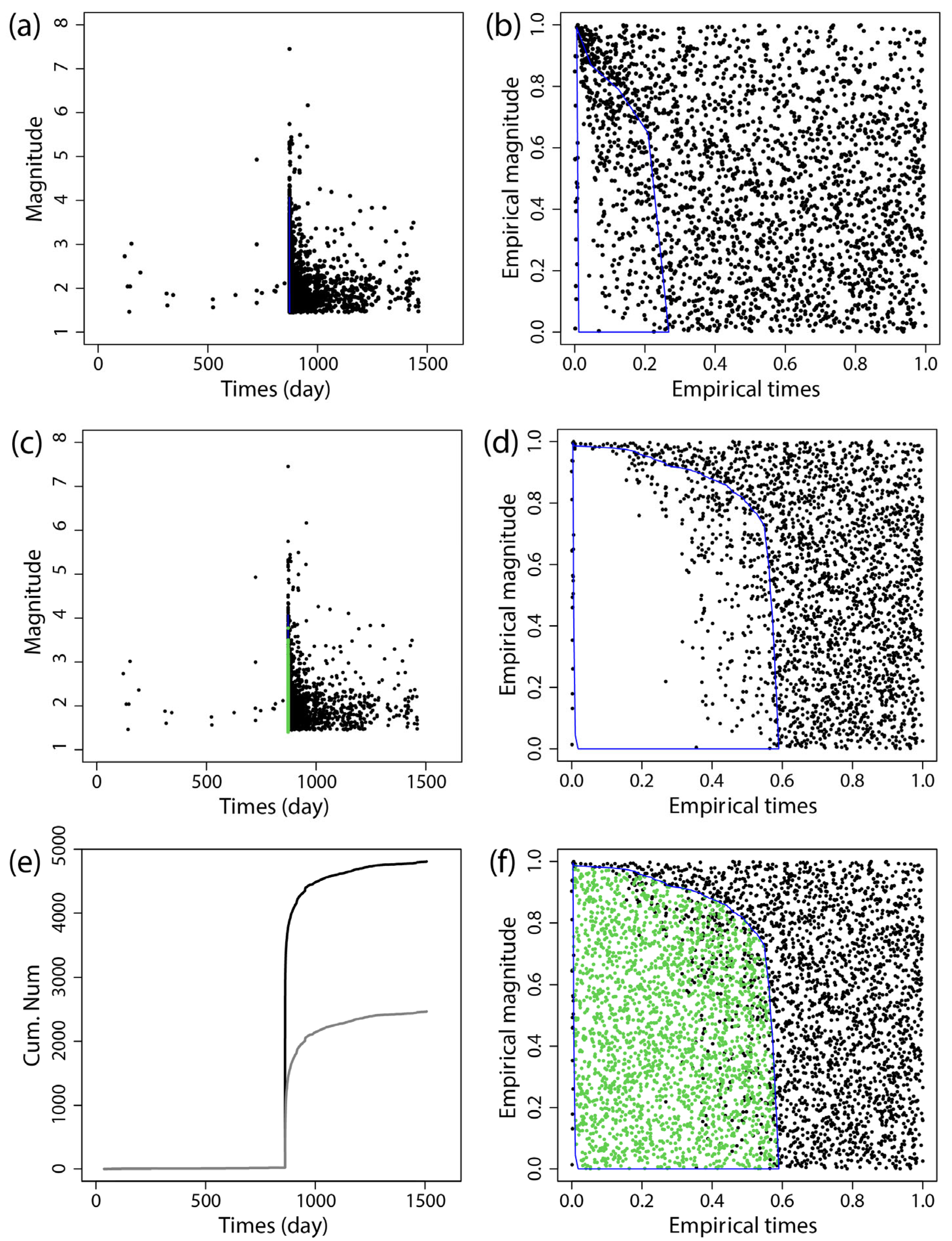
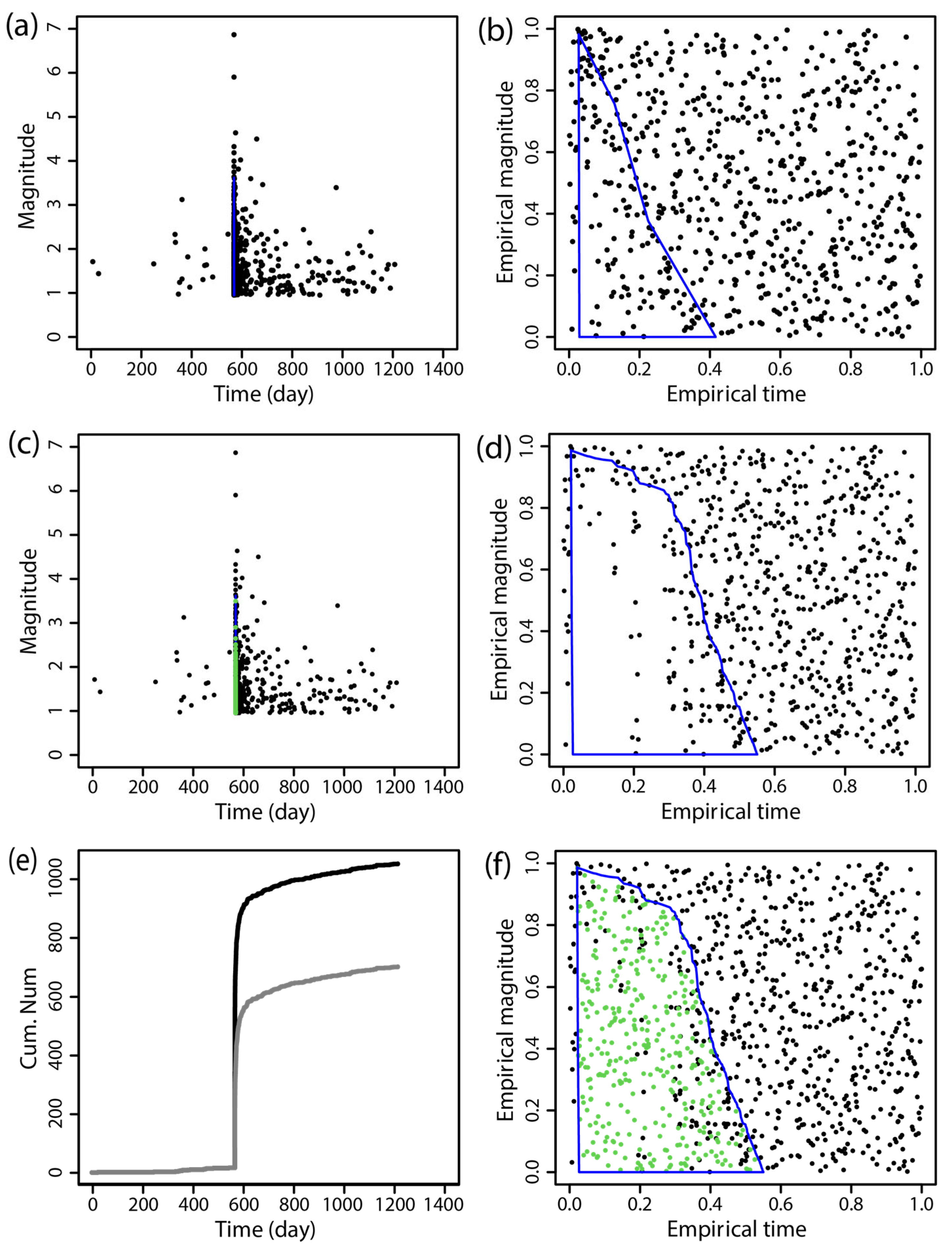
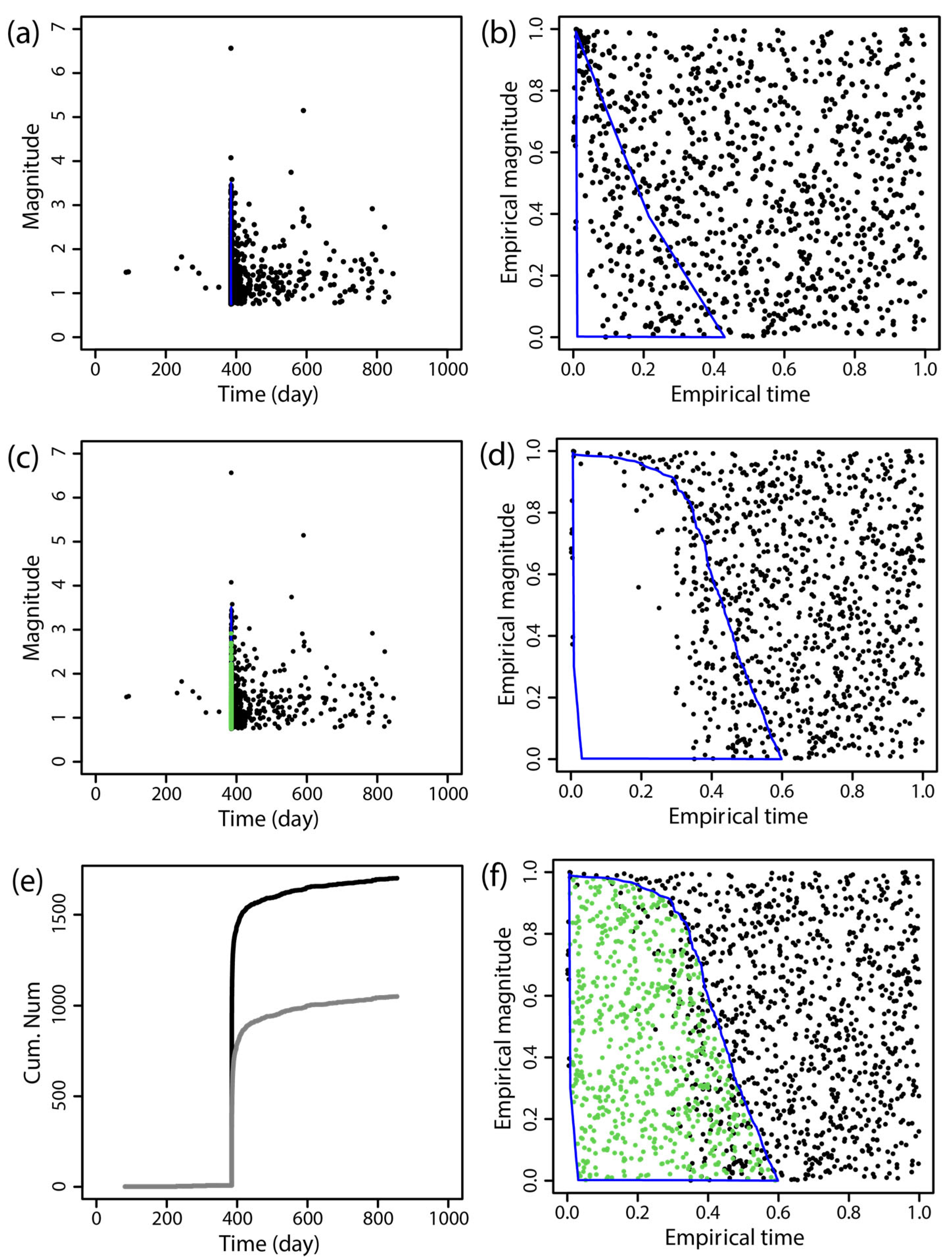
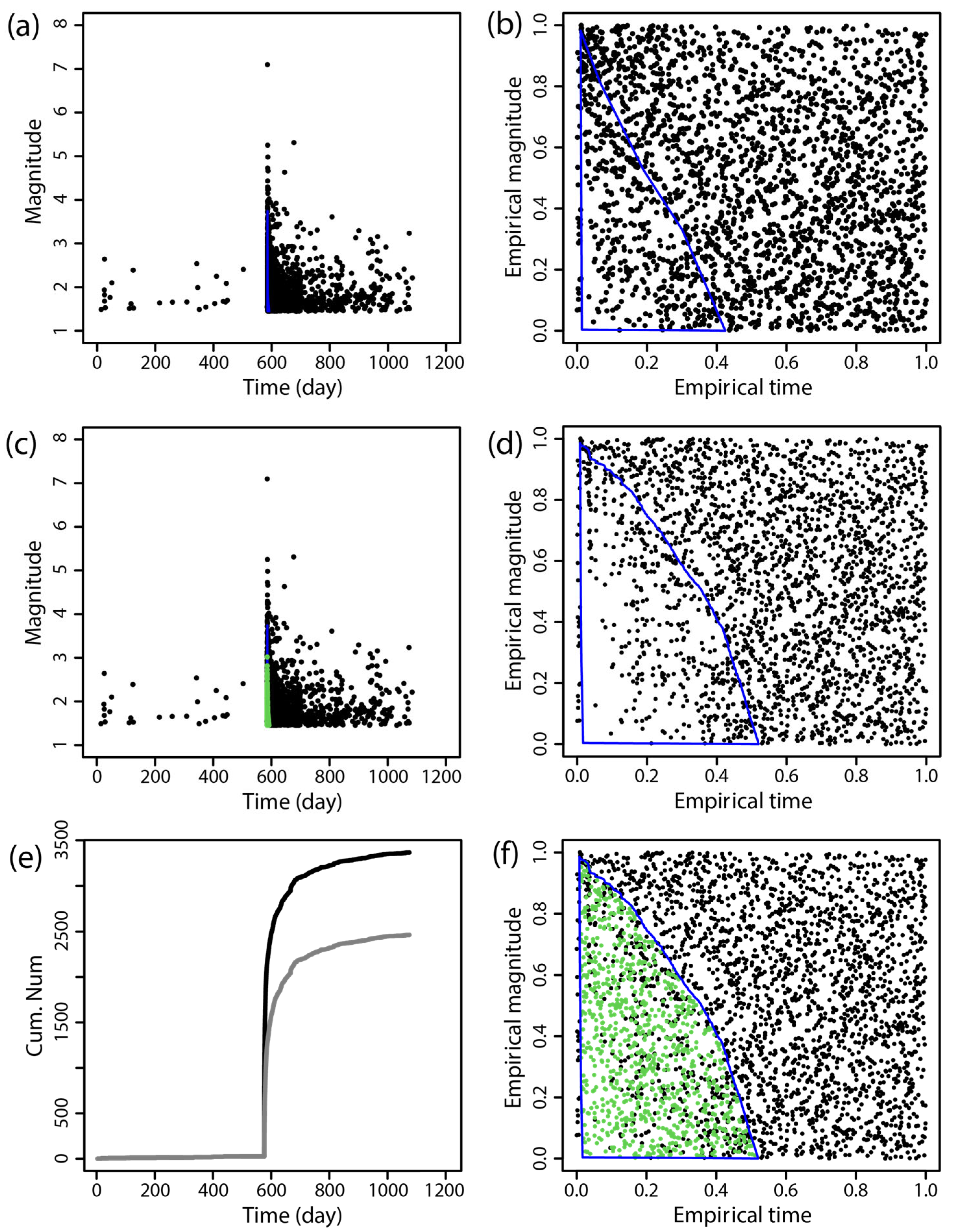
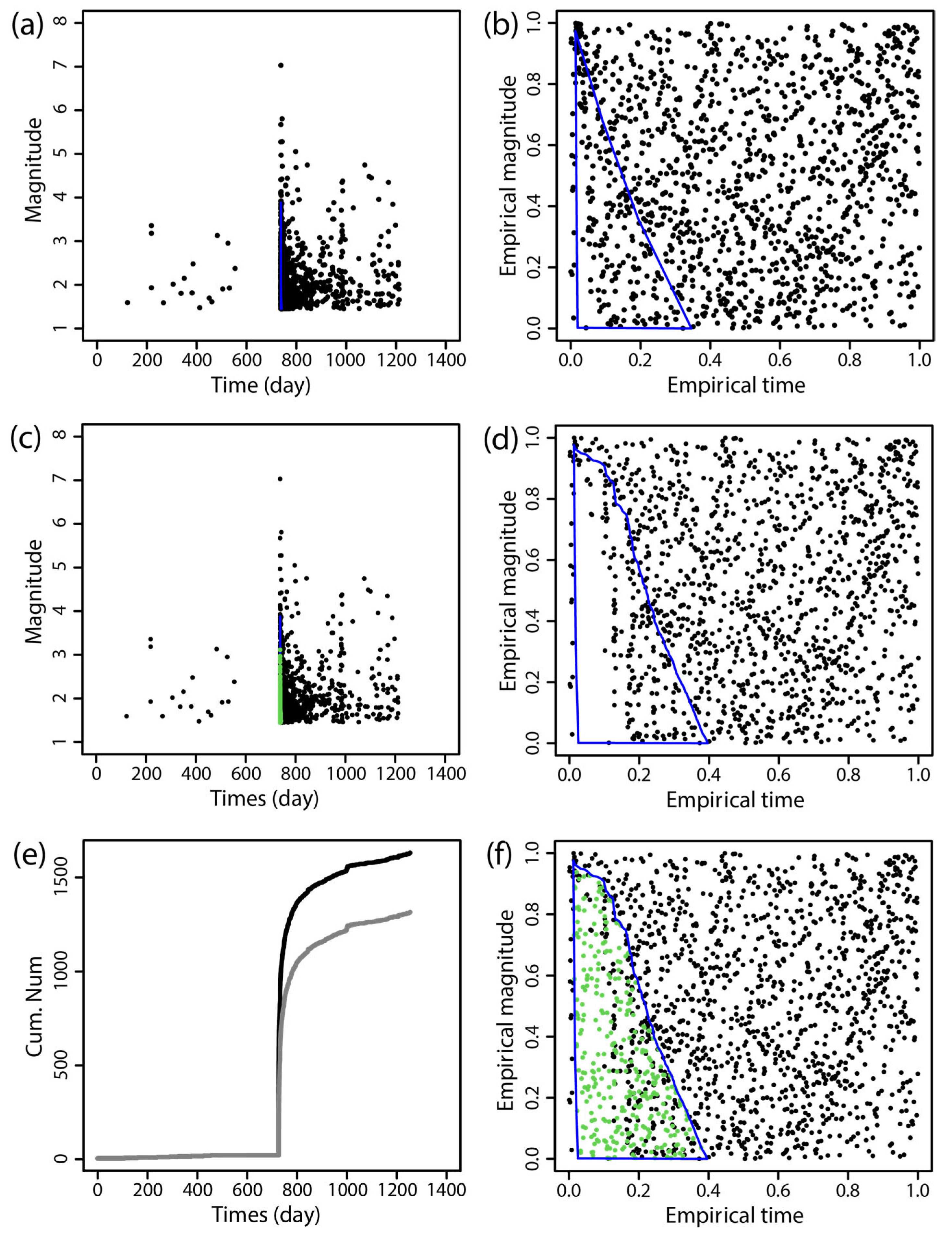
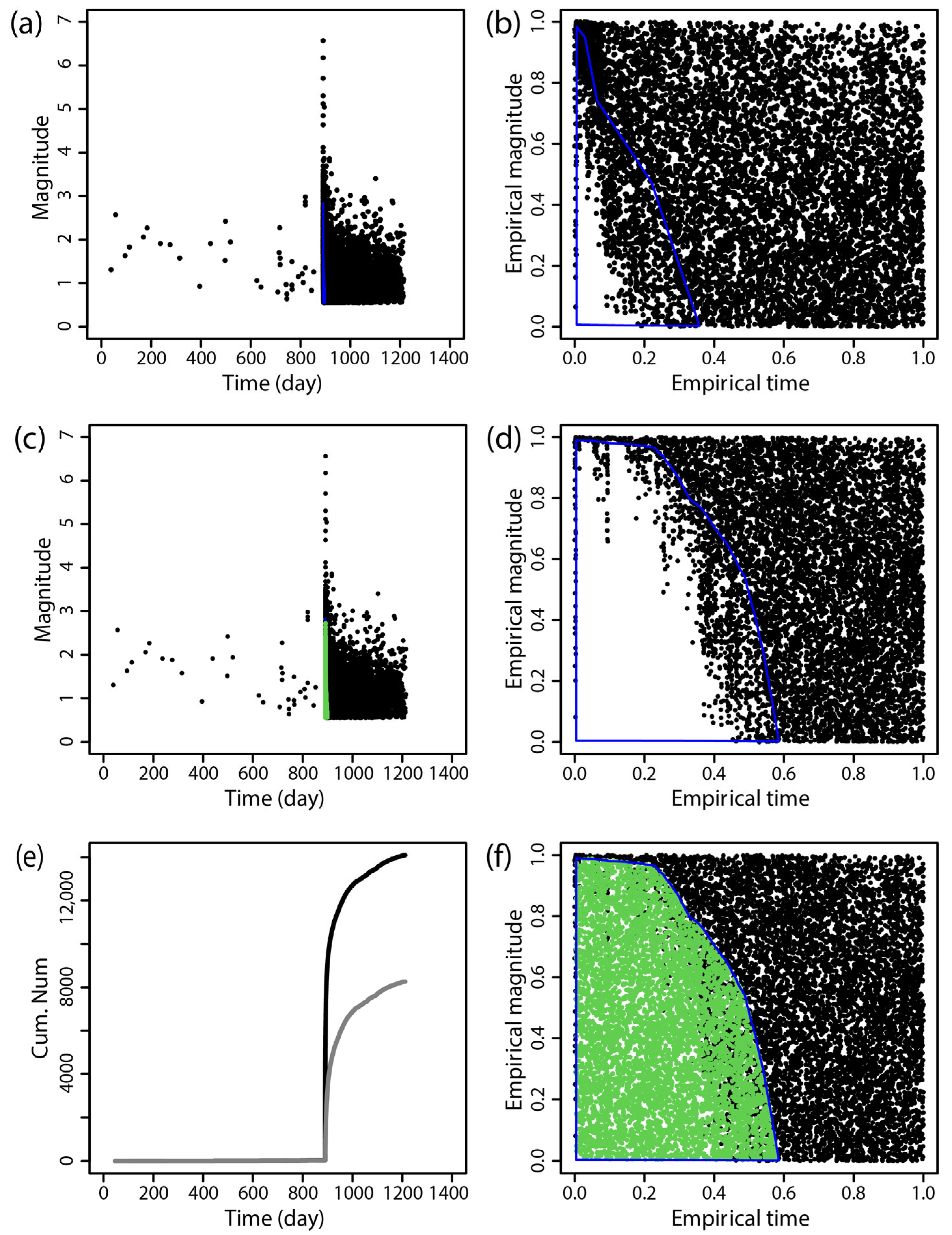

| Time (dd-mm-yyyy) | Region | MS | Mc Before Supplementing | Mc After Supplementing |
|---|---|---|---|---|
| 22 May 2021 | Maduo | 7.4 | 2.9 | 1.5 |
| 22 July 2013 | Minxian | 6.6 | 2.4 | 1.0 |
| 22 January 2016 | Menyuan | 6.4 | 1.5 | 0.8 |
| 8 August 2017 | Jiuzhaigou | 7.0 | 2.1 | 1.5 |
| 8 January 2022 | Menyuan | 6.9 | 2.0 | 1.5 |
| 10 June 2022 | Maerkang | 6.0 | 2.0 | 0.6 |
| Index | Seismic Sequence | Sequence Type | Fault Type | μ | A | α | c | p | b | Background Earthquake Probability of Main Earthquake | ||
|---|---|---|---|---|---|---|---|---|---|---|---|---|
| Time (dd-mm-yyyy) | Region | MS | ||||||||||
| 1 | 22 May 2021 | Maduo | 7.4 | M-A | strike-slip | 0.0182 | 0.2711 | 1.0767 | 0.0823 | 1.1842 | 0.9073 ± 0.015 | 0.7625 |
| 2 | 22 July 2013 | Minxian | 6.6 | M-A | strike-slip and thrust | 0.0001 | 0.0032 | 2.2439 | 0.0121 | 1.1032 | 0.7700 ± 0.042 | 0.7522 |
| 3 | 22 January 2016 | Menyuan | 6.4 | M-A | thrust | 0.0328 | 0.0005 | 2.6892 | 0.1087 | 1.2776 | 1.0598 ± 0.060 | 1.0000 |
| 4 | 8 August 2017 | Jiuzhaigou | 7.0 | M-A | strike-slip | 0.0002 | 0.0738 | 1.9214 | 0.0291 | 1.1547 | 1.1139 ± 0.025 | 0.2853 |
| 5 | 8 January 2022 | Menyuan | 6.9 | M-A | strike-slip | 0.0022 | 0.0173 | 2.2601 | 0.0051 | 1.0388 | 0.8691 ± 0.026 | 0.9241 |
| 6 | 10 June 2022 | Maerkang | 6.0 | S | strike-slip | <0.0001 | 0.2689 | 1.7713 | 0.0071 | 1.0576 | 1.2792 ± 0.027 | <0.001 |
| Cutoff Magnitude | μ | A | α | c | p | b |
|---|---|---|---|---|---|---|
| ML1.7 | 0.000192 | 0.073782 | 1.921365 | 0.029117 | 1.154718 | 1.1139 ± 0.025 |
| ML1.8 | 0.000293 | 0.020183 | 2.230346 | 0.016399 | 1.178645 | 1.0088 ± 0.032 |
| ML1.9 | 0.000255 | 0.018494 | 2.257887 | 0.009518 | 1.168921 | 1.0089 ± 0.035 |
Disclaimer/Publisher’s Note: The statements, opinions and data contained in all publications are solely those of the individual author(s) and contributor(s) and not of MDPI and/or the editor(s). MDPI and/or the editor(s) disclaim responsibility for any injury to people or property resulting from any ideas, methods, instructions or products referred to in the content. |
© 2025 by the authors. Licensee MDPI, Basel, Switzerland. This article is an open access article distributed under the terms and conditions of the Creative Commons Attribution (CC BY) license (https://creativecommons.org/licenses/by/4.0/).
Share and Cite
Wang, Y.; Wang, R.; Han, P.; Zhao, T.; Miao, M.; Su, L.; Jin, Z.; Zhuang, J. Statistical Characteristics of Strong Earthquake Sequence in Northeastern Tibetan Plateau. Entropy 2025, 27, 174. https://doi.org/10.3390/e27020174
Wang Y, Wang R, Han P, Zhao T, Miao M, Su L, Jin Z, Zhuang J. Statistical Characteristics of Strong Earthquake Sequence in Northeastern Tibetan Plateau. Entropy. 2025; 27(2):174. https://doi.org/10.3390/e27020174
Chicago/Turabian StyleWang, Ying, Rui Wang, Peng Han, Tao Zhao, Miao Miao, Lina Su, Zhaodi Jin, and Jiancang Zhuang. 2025. "Statistical Characteristics of Strong Earthquake Sequence in Northeastern Tibetan Plateau" Entropy 27, no. 2: 174. https://doi.org/10.3390/e27020174
APA StyleWang, Y., Wang, R., Han, P., Zhao, T., Miao, M., Su, L., Jin, Z., & Zhuang, J. (2025). Statistical Characteristics of Strong Earthquake Sequence in Northeastern Tibetan Plateau. Entropy, 27(2), 174. https://doi.org/10.3390/e27020174










